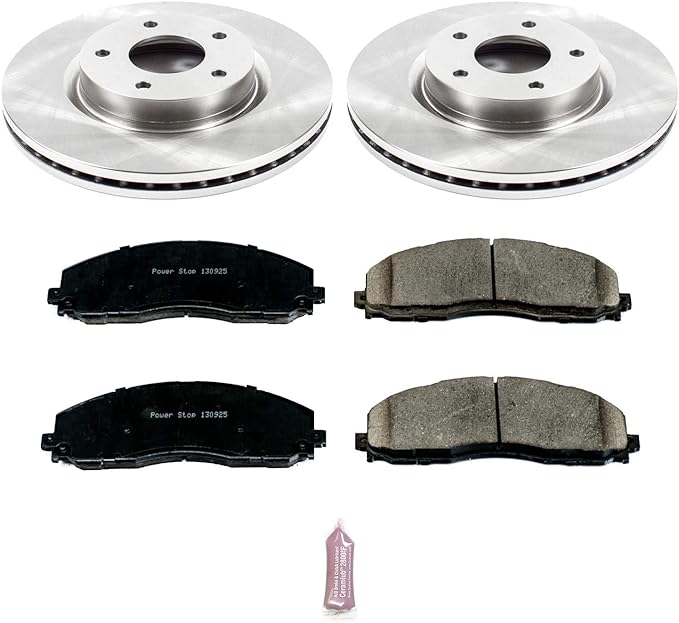Let’s look at the various telltale signs that you need to check or replace your car’s brake rotors.
Squealing or Grinding Noises
Excessive noise coming from your vehicle’s brakes, specifically if it is a grinding, squealing or vibrating noise is a sign that your rotors are in need of inspection. The noises mentioned could indicate various problems with the brake rotors that require immediate attention.
One of the reasons why the noise happens is because as the brake pads wear down, their metal backing may come into direct contact with the rotor, causing a metal-on-metal grinding noise.
If you notice squealing or grinding noises when you hit the brakes, there may be an issue with the brake rotors. Squealing usually means that the brake pads have worn down. If you notice both squealing and a harsh grinding sound like metal grinding against metal, it could indicate that the rotors are damaged.
Another reason for noisy brakes can be the presence of debris or small rocks caught between the brake pad and the rotor, which can produce a squealing sound.
Additionally, if the rotors are unevenly worn, or if they have developed grooves and pits, the brake pads may not make smooth, even contact with the rotor surface, leading to noise during braking.
It’s also possible for rotors to make noise if they’ve been exposed to excessive heat and have warped. This warping can cause the rotor to throb against the brake pads as they are applied, creating a pulsating noise.
In some cases, the wear indicator tabs on brake pads will emit a high-pitched screech to alert the driver that the pads are due for replacement, which indirectly indicates that the rotors should be inspected for wear as well.
Regular inspection and maintenance of the brake system, including the rotors and brake pads, is essential for preventing these noises and ensuring safe braking performance.
Vibrations or Pulsations While Braking
A shaking sensation in the steering wheel while braking is often an early indication of problems with the brake rotors. Uneven brake rotors can cause inaccurate brake clamping, as the brake pads clamp down on these uneven surfaces, the variations in the rotor thickness (also known as rotor runout) can cause the brake pads to move in and out, translating into a vibration that can be felt in the steering wheel
If you feel vibrations or pulsations in the steering wheel, brake pedal, or vehicle itself when you brake, this could mean that the brake rotors have warped or worn unevenly. This can affect how smoothly and effectively your car can slow down and stop.
Uneven rotor thickness is typically caused by rust buildup or overheating of the rotors. Rust buildup on the rotors can compromise the airflow through the rotors, resulting in heat accumulation. The intense heat generated from friction between the brake pads and rotors may cause them to become distorted and deformed, resulting in these unsettling vibrations.
It’s important to have this checked promptly as it may require resurfacing or replacing the rotor. Ignoring this warning sign could compromise your ability to slow down effectively and potentially lead to more serious issues affecting both your braking system performance and safety on the road.
Longer Stopping Distances
If you notice that it’s taking longer for your vehicle to stop after you hit the brakes, it’s time to bring it in for a service at our service department in Fairfield, Ohio. Bad brake rotors can affect your vehicle’s stopping power. As this can be dangerous even for everyday driving, let alone emergency situations, it’s very important to address the issue as soon as possible.
One noticeable effect of worn brake rotors is the increase in stopping distance, which poses a potential safety hazard, especially during emergency situations.
As the rotors wear down, their ability to provide friction and even contact with the brake pads decreases, making it more challenging for drivers to bring their vehicle to a quick stop.
Poor contact between the rotor surface and pads can generate excessive heat that may lead to warping of the rotor.
This Exacerbates longer stopping distances and increases braking time.
Steps To Address Bad Brake Rotors
Types of Brake Rotors and Their Uses
Depending on your driving style and terrain, there is a wide variety of brake rotors available, each with its own unique characteristics and lifespan.
The most common type of rotor found in new passenger vehicles is the plain rotor, which can withstand moderate levels of heat and works well for regular driving.
Drilled rotors have holes that improve braking performance in wet climates, but may wear out faster when exposed to high temperatures. It’s crucial to select the right type of brake rotor for your specific driving needs when considering replacement options.
For heavy-duty trucks and SUVs, slotted rotors are often used due to their durability against cracks as well as improved stopping power by channeling away gas and dust particles.
Another popular option is combining both drilled and slotted patterns on one rotor for enhanced benefits such as effective heat dispersion while maintaining consistent contact with pads. These types tend to have shorter lifespans.


